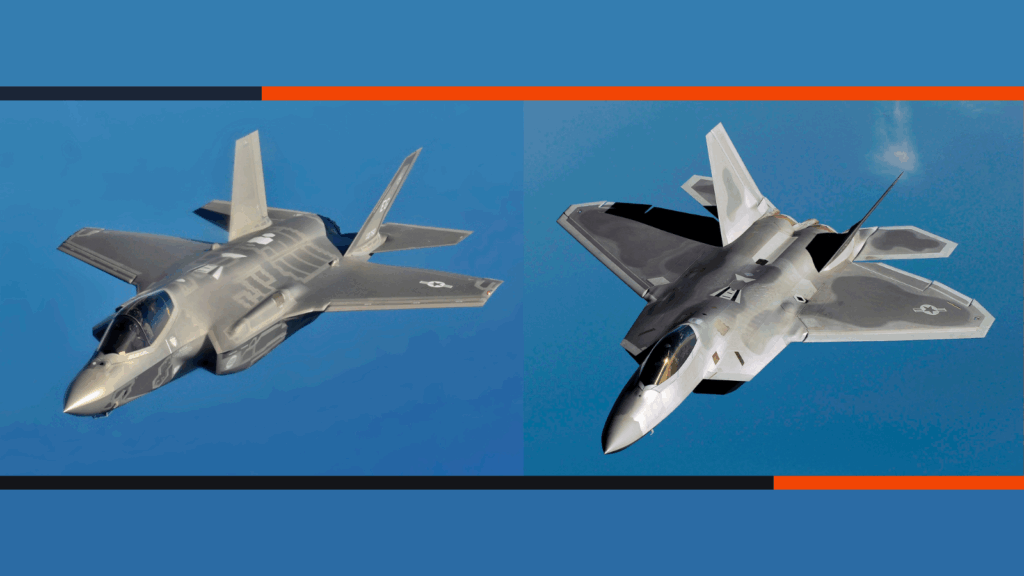
The sleek, imposing silhouettes of the F-22 Raptor and the F-35 Lightning II have dominated discussions of air power for over a decade. Often pitted against each other in hypothetical dogfights and endless debates over which is “better,” this framing fundamentally misunderstands their intended purposes. These are not rivals in a competition for the same role, but rather two essential and complementary components of a sophisticated, 21st-century air combat strategy.
The F-22 is the eagle, soaring to establish dominance of the skies, while the F-35 is the versatile and networked quarterback, orchestrating the multi-domain battle below.The common misconception of an F-22 versus F-35 rivalry stems from a surface-level comparison of their specifications. The F-22, with its twin-engine design, superior speed, and unparalleled maneuverability, is an undisputed king of air-to-air combat. The F-35, a single-engine, multi-role fighter, cannot match the Raptor’s raw kinematic performance.
However, to declare the F-22 the victor based on these metrics alone is to miss the forest for the trees. The true genius of modern American air power lies not in a single platform, but in the synergistic way these two fifth-generation fighters are designed to operate in concert.
The Unmatched Hunter: The F-22 Raptor’s Domain
The Lockheed Martin F-22 Raptor was conceived during the Cold War with a singular, vital mission: to be the most dominant air superiority fighter ever built. Its development was a direct response to the threat of advanced Soviet fighters and integrated air defense systems. Every aspect of the F-22’s design is optimized for this role.
Its combination of stealth, supercruise (the ability to sustain supersonic flight without afterburners), and extreme maneuverability allows it to penetrate contested airspace, hunt down and destroy enemy aircraft, and establish air dominance before the adversary even knows it is under attack. The F-22’s AN/APG-77 radar is a powerful tool for detecting and tracking threats at long ranges, while its stealth characteristics make it incredibly difficult to detect in return.
However, the very specialization that makes the F-22 so lethal in its primary role also imposes limitations. Its Intra-Flight Data Link (IFDL) was designed for secure communication between F-22s, but it is not inherently compatible with the broader network of legacy and allied aircraft. While upgrades are in progress, this has historically presented a challenge for seamless data sharing across the battlespace. Furthermore, the F-22’s air-to-ground capabilities, while present, are not as advanced or extensive as those of the F-35. Production of the F-22 was capped at 187 operational aircraft for the U.S. Air Force, making it a precious and strategically deployed asset.
The All-Seeing Quarterback: The F-35 Lightning II’s Networked Warfare
The Lockheed Martin F-35 Lightning II, born from the Joint Strike Fighter program, was designed with a different philosophy. It is a multi-role fighter intended to be the backbone of the air fleets of the U.S. Air Force, Navy, and Marine Corps, as well as a growing number of allied nations. The F-35’s strength lies not in its individual performance metrics, but in its unparalleled situational awareness and its role as a force multiplier.
The F-35’s most revolutionary feature is its sensor fusion. It is equipped with a suite of advanced sensors, including the AN/APG-81 AESA radar, the Distributed Aperture System (DAS), and the Electro-Optical Targeting System (EOTS). These systems gather vast amounts of data from the surrounding environment, which is then fused and presented to the pilot in a single, intuitive display. This gives the F-35 pilot a “God’s-eye view” of the battlespace, allowing them to see and understand threats and opportunities in a way no previous aircraft could.
Crucially, the F-35 is designed to share this wealth of information. Its Multifunction Advanced Data Link (MADL) allows it to securely communicate with other F-35s, and it is also equipped with Link 16 to communicate with legacy aircraft and other assets. This turns the F-35 into a “quarterback” in the sky, capable of directing other aircraft, including the F-22, to targets it has identified, all while remaining undetected.
A Symphony of Destruction: How the F-22 and F-35 Fight Together
In a conflict scenario against a peer or near-peer adversary, the F-22 and F-35 would not be engaged in a competition, but in a carefully choreographed ballet of destruction.
The Opening Act: The Raptor’s Sweep
The initial phase of an air campaign would likely see the F-22s taking the lead. Their mission: to “kick down the door” of the enemy’s air defenses. Flying high and fast, the Raptors would use their stealth and superior kinematics to hunt down and eliminate the most advanced enemy fighters and surface-to-air missile (SAM) threats. They would create a safe corridor for other, less stealthy assets to follow.
The Main Event: The Lightning’s Orchestra
Once the F-22s have sanitized the airspace, the F-35s would enter the fray. Operating in a more permissive environment, the F-35s would leverage their advanced sensors to identify and track a wide range of targets on the ground and in the air. A key tactic would be for the F-35s to use their “quarterback” capabilities. An F-35 could, for example, detect a high-value mobile target deep behind enemy lines. Without exposing itself by using its own radar, it could then securely transmit that targeting data to a flight of F-22s, which could then engage the target with their air-to-ground munitions.
This networked approach allows for a level of coordination and lethality never before seen. The F-35, with its panoramic view of the battlefield, can direct the F-22s, with their specialized air-to-air and precision strike capabilities, to the most critical threats.
The Numerical Reality: A Tale of Two Fleets
The strategic landscape for the F-22 and F-35 isn’t just about their individual capabilities; it’s heavily influenced by the stark difference in their production numbers and operational realities. This numerical disparity shapes how the U.S. and its allies approach air power in a rapidly evolving global environment.
The F-22 Raptor, while an undisputed king of air dominance, is a rare and precious asset. Its production run ended with only 195 aircraft built. After accounting for accidents, non-combat training variants, and ongoing maintenance, the U.S. Air Force currently has roughly 150 combat-capable Raptors. This limited fleet size presents a significant strategic challenge, especially given the accelerating advancements of peer adversaries like China. Beijing is not only fielding a growing number of its own fifth-generation Chengdu J-20 fighters but is also actively developing next-generation aircraft, posing an increasing threat that a small F-22 fleet must contend with.
In stark contrast, the F-35 Lightning II represents the backbone and sheer volume of modern air power. As a multi-role fighter, its production has been far more extensive, with Lockheed Martin having delivered approximately 1,200 F-35s globally. Over 450 of these are already in service with the U.S. Air Force alone, with many more destined for the Navy, Marine Corps, and numerous allied nations. This widespread deployment makes the F-35 the primary platform for networked warfare and extensive situational awareness across a vast operational theater.
Given these realities, the U.S. Air Force is pursuing a dual-pronged strategy. They are intensely focused on maintaining the readiness and combat effectiveness of the existing F-22 fleet, ensuring these elite fighters remain at the cutting edge. Simultaneously, they are heavily investing in the development of a sixth-generation fighter jet. This future aircraft is designed to address the emerging threats and technological gaps that the current limited F-22 fleet, even with its F-35 synergy, will eventually face. This strategic outlook underscores the ongoing adaptation required to maintain air superiority in the decades to come.
Data Fusion and the Future of Joint Operations
The challenge of making the F-22’s IFDL and the F-35’s MADL talk to each other has been a significant focus of development. The U.S. Air Force has been actively working on gateways and translation systems to allow for seamless data flow between the two platforms. The goal is to create a truly integrated fifth-generation force where the unique strengths of each aircraft are fully leveraged.
The proliferation of the F-35 among allied nations further enhances this strategic advantage. In a coalition operation, allied F-35s can seamlessly integrate with U.S. F-22s and F-35s, creating a unified and overwhelming force.
In conclusion, the debate over whether the F-22 is “better” than the F-35 is a red herring. The more insightful question is how these two remarkable aircraft work together to create a sum that is far greater than its parts. The F-22 is the indispensable tool for achieving air dominance, the silent hunter that paves the way. The F-35 is the master of information, the networked hub that orchestrates the complex, multi-domain battle. Together, they represent a paradigm shift in air warfare, a testament to the power of complementary design and networked integration. The future of air power is not about a single, ultimate fighter; it is about the seamless and devastating synergy of the Raptor and the Lightning.
